Samsung Galaxy Tab Pro 8.4 and 10.1 Review
by Jarred Walton on March 22, 2014 9:30 PM ESTPerformance Benchmarks
In the world of laptops where I come from, we’re fast reaching the point – if not well beyond it – where talking about raw performance only matters to a small subset of users. Everything with Core i3 and above is generally “fast enough” that users don’t really notice or care. For tablets, the difference in speed between a budget and a premium device is far more dramatic. I’ve included numbers from the Dell Venue 8, which I’ll be providing a short review of in the near future. While the price isn’t bad, the two Samsung tablets feel substantially snappier – as they should. We’ll start with the CPU/system benchmarks and then move to the GPU/Graphics tests.
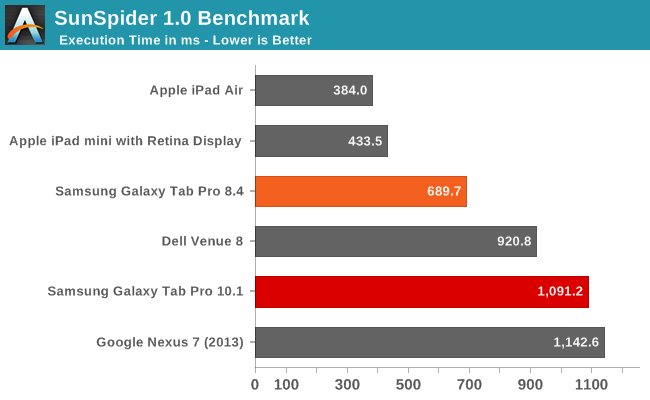
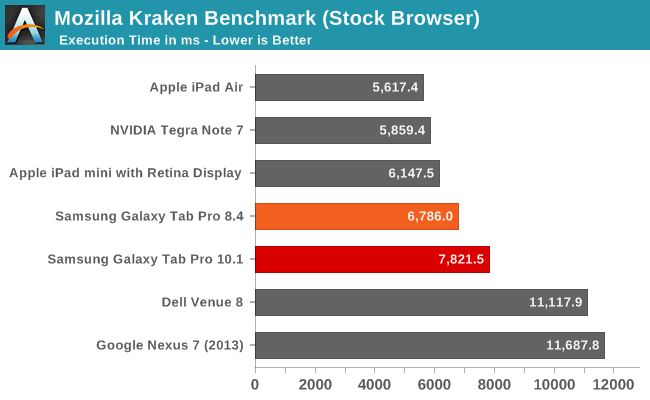
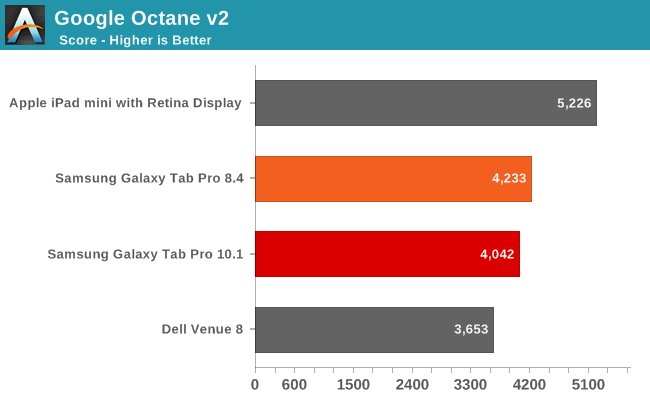

In terms of CPU speed, the Apple A7 chips still take the lead in all of our tests, though not always by a large margin. We’re also using different browsers (Chrome vs. Safari), and JavaScript benchmarks aren’t always the greatest way of comparing CPU performance. I ran additional benchmarks on the two Samsung tablets just to see if I could get some additional information; you can find a table of results for AndeBench, Basemark OS II, and Geekbench 3.
| CPU/System Benchmarks of Samsung Galaxy Tab Pro | |||
| Benchmark | Subtest | Tab Pro 10.1 | Tab Pro 8.4 |
| Andebench | Native | 13804 | 17533 |
| Java | 708 | 790 | |
| Basemark OS II | Overall | 865 | 1062 |
| System | 1542 | 1529 | |
| Memory | 419 | 503 | |
| Graphics | 1032 | 2555 | |
| Web | 838 | 724 | |
| Geekbench 3 | Single | 942 | 910 |
| Multi | 2692 | 2847 | |
| Integer Single | 1028 | 967 | |
| Integer Multi | 3135 | 3343 | |
| FP Single | 897 | 848 | |
| FP Multi | 3106 | 3080 | |
| Memory Single | 860 | 922 | |
| Memory Multi | 982 | 1391 | |
Interestingly, the Samsung Exynos 5 Octa 5420 just seems to come up short versus the Snapdragon 800 in most of these tests. However, there’s a bit more going on than you might expect. We checked for cheating in the benchmarks, and found no evidence that either of these tablets was doing anything unusual in terms of boosting clock speeds. What we did find is that the Pro 10.1 is frequently not running at maximum frequency – or anywhere near it – in quite a few of our CPU tests.
Specifically, Sunspider, Kraken, and Andebench had the cores hitting a maximum 1.1-1.3GHz. The Pro 8.4 meanwhile would typically hit the maximum 2.3GHz clock speed. The result, as you might imagine, is that the 8.4 ends up being faster, sometimes by a sizeable margin. Basemark OS II, Geekbench 3, and AnTuTu on the other hand didn’t have any such odd behavior, with the Pro 10.1 often hitting 1.8-1.9GHz (on one or more cores) during the testing, and when that happens it often ends up slightly faster than the Pro 8.4.
Which benchmark results are more "valid"? Well, that's a different subject, but as we're comparing Samsung tablets running more or less the same build of Android, we can reasonably compare the two and say that the 8.4 has better overall performance. Updated drivers or tweaking of the power governor on the 10.1 might change things down the road, but we can only test what exists right now.
Overall, both systems are sufficiently fast for a modern premium tablet, so I wouldn’t worry too much about whether or not you’re getting maximum clock speeds in a few benchmarks – in normal use you likely won’t notice one way or the other. But we’re only talking about the CPU performance when we say you won’t see the difference; let’s move over to the graphics benchmarks to see how the Galaxy Pro tablets fare.
Graphics Performance
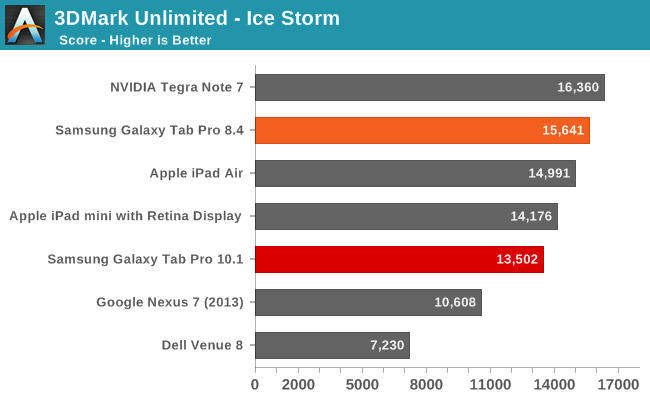
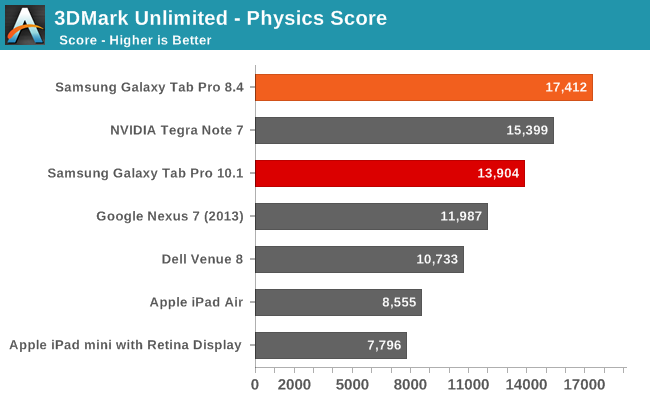
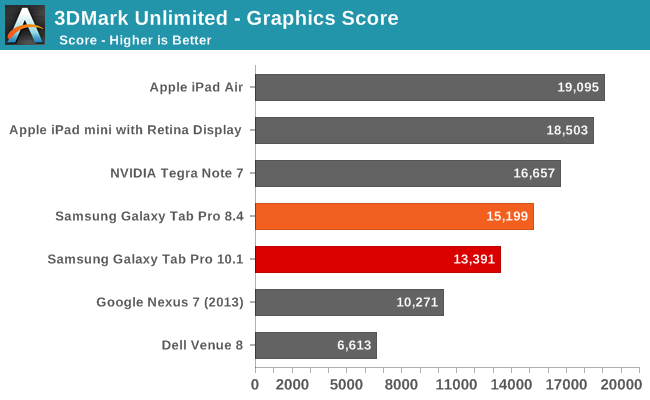
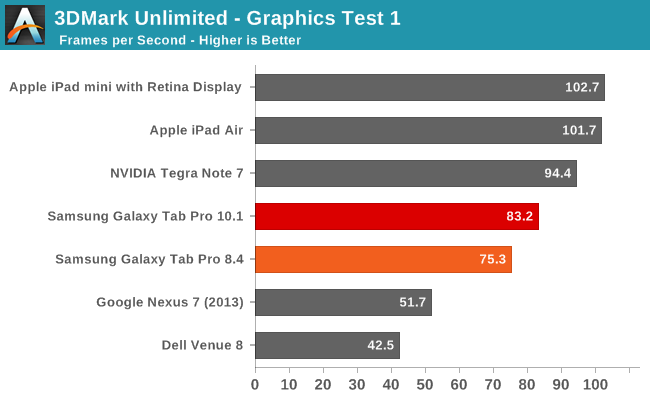
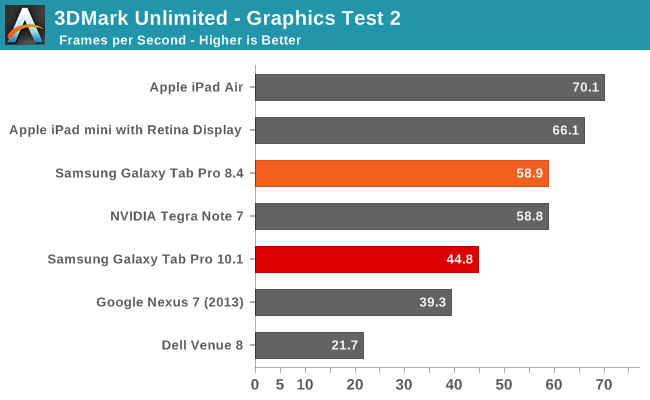
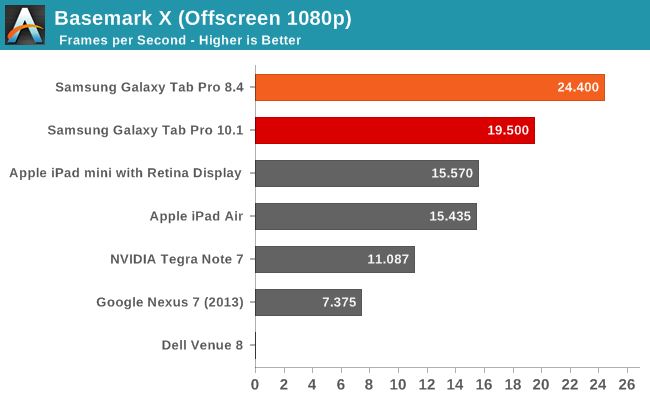
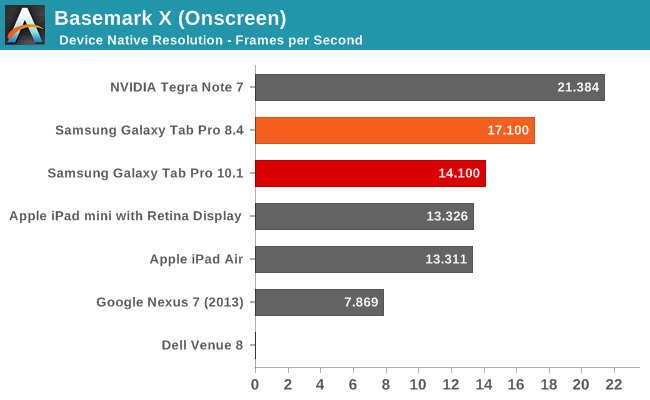
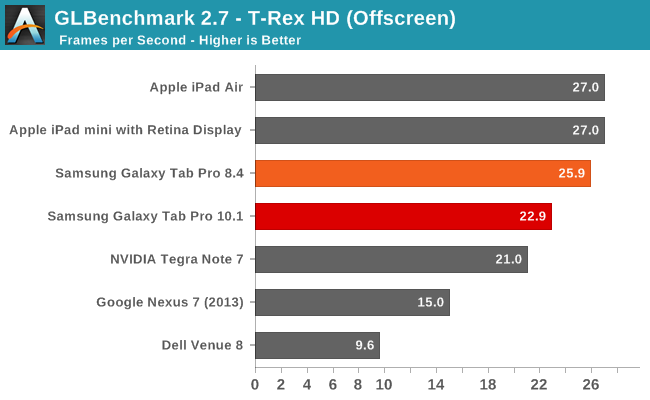
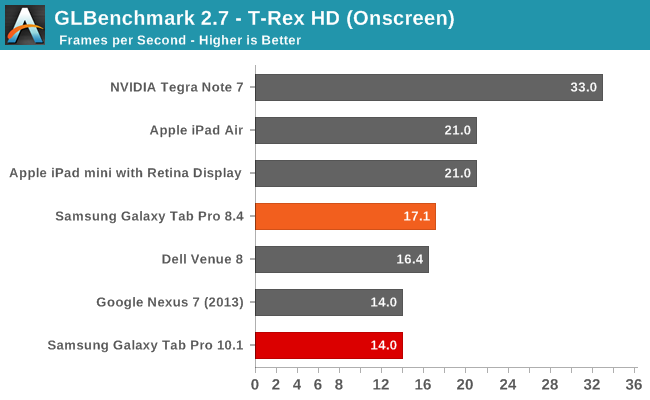
Outside of the 3DMark Unlimited Graphics Test 1 result, the Pro 8.4 sweeps the tables against its big brother. Playing games like Angry Birds Go! or any other reasonably demanding 3D titles in my experience confirms the above results – Adreno 330 beats the Mali-T628; end of discussion. I also had a few quirks crop up with the Pro 10.1 graphics, like Plants vs. Zombies 2 at one point stopped rendering all the fonts properly; a reboot fixed the problem, but I may have seen one or two other rendering glitches during testing. I have some additional results for GPU testing as well via GFXBench 3.0 if you’re interested:
| Graphics Benchmarks of Samsung Galaxy Tab Pro | |||
| Benchmark | Subtest | Tab Pro 10.1 | Tab Pro 8.4 |
| GFXBench 3.0 Onscreen | Manhattan (FPS) | 2.9 | 5.8 |
| T-Rex (FPS) | 14 | 17.1 | |
| ALU (FPS) | 13 | 59.8 | |
| Alpha Blending (MB/s) | 3295 | 6847 | |
| Fill (MTex/s) | 1956 | 3926 | |
| GFXBench 3.0 Offscreen | Manhattan (FPS) | 5.5 | 10.8 |
| T-Rex (FPS) | 22.9 | 25.9 | |
| ALU (FPS) | 25.6 | 138 | |
| Alpha Blending (MB/s) | 3093 | 7263 | |
| Fill (MTex/s) | 1956 | 3780 | |
The new Manhattan benchmark was one of the other tests where the Pro 10.1 didn’t seem to render things properly, and even then the Pro 8.4 ends up with nearly twice the frame rates. The ALU, Alpha Blending, and Fill rate scores might explain some of what’s going on, where in some cases the Pro 8.4 is more than four times as fast. Regardless, if you want maximum frame rates, I’d suggest getting the Pro 8.4 over the 10.1.










125 Comments
View All Comments
TestKing123 - Tuesday, March 25, 2014 - link
It's true the Yogo 2 Pro is in an entirely different segment/market than an Ipad or Android tablet, but I found I'm using this device far more often than any of my other tablets. The screen is 13.3 but a beautiful QHD display (higher than Retina), very responsive and incredibly fast. The major apps are all on Windows 8 anyways, though I don't care for the App store that much. I can use it as a tablet or PC with a flip of the backside, and I can run all my business software AND play some decent PC games as well.It literally made by tablet collection (and I love buying the newest tablets) obsolete.
johnny_boy - Sunday, March 23, 2014 - link
I think the lg g pad 8.3 makes a good lower cost competitor to the tab pro 8.4. It's sporting previous gen snapdragon soc but 2gb ram and basically the same dimensions and weight. I personally don't think the extra cost of the tab is worth it over the g pad.RobilarOCN - Monday, March 24, 2014 - link
Have you owned a G Pad? I recently sold mine and switched to the Tab Pro 8.4. You might want to have a look at the XDA forum section for it. Despite an amazing aluminum body, the screen on the G Pad is terrible. I paid $350 for it (got it before LG heavily discounted it and then released the google play edition). It is hands down the dimmest tablet screen I have ever used. I was lucky enough not to get one of the "crappy" ones (of which there are apparently many), I didn't have the blue line of doom on the screen or excessive light bleed around the edges (Both of which are very common). Still, even at 100% brightness, it is dimmer than a Nexus 7 or a tab pro at 50%. Impossible to use in sunlight (I took it on vacation). Also the battery life was not good. There is a reason that LG dropped the tablet price by $100 within a month of it's release. Too bad because it has a lot of other amazing things going for it. The screen is the deal breaker though. So yes, the extra cost makes it a big difference... Plus LG is discontinuing the $250 version in favor of the $350 google play edition. A $50 difference for a vastly better screen, faster SOC and better battery? Abolutelywintermute000 - Monday, March 24, 2014 - link
if u can't ROM away the custom magazine UI then no sale. Haven't kept up but aren't Sammy devices getting harder and harder to mod?Woody - Sunday, March 23, 2014 - link
Haha!! what age do you consider "getting old"This is exactly what I'm thinking when I look at screen size these days....thinking about switching from my Galaxy S series for a Galaxy Note for this very reason.
Or I could just get reading glasses. ughh!
frozentundra123456 - Sunday, March 23, 2014 - link
Nice, but more than I would pay for any android device.martixy - Monday, March 24, 2014 - link
That moment when you skim the specs and notice that the display size is always bigger than the stated physical dimensions of the device.It takes a second...
skrewler2 - Friday, March 28, 2014 - link
You mentioned the Note 2014 having the same specs on the first page, but didn't include these in any of the benchmarks to confirm they are indeed the same tablet with just the inclusion of the S-Pen?Also, you didn't include a comparison between the Note / Note pro / Galaxy / Galaxy pro in your closing thoughts.
I got my Galaxy Note 10.1 2014 edition on special for $400 back in Jan (also w/ a bunch of goodies.. Google store credit, Samsung store credit, Dropbox, evernote pro, a bunch of other stuff). I was kinda bummed that shortly after I purchased it that the Note Pros came out, but other than 10" vs 12" it's hard to tell what exactly is different between them. I remember coming to the conclusion that the Pro model adds some features for businesses / BYOD, notably for compliance and security.
Does it just come down to Note 10.1 2014 being 10" and Note Pro 12 being 12"? Doesn't seem worth the $300 price premium. I also just ran the Sunspider benchmark on my Note 2014 and consistently get scores around 500ms.
maximumGPU - Monday, March 24, 2014 - link
Thumbs up to Jarred for being very active on the comments section and replying to questions or concerns.az_ - Monday, March 24, 2014 - link
I am wondering, why aren't you comparing these Pro tablets to something with Windows, just to other android tablets and the iPad? I guess if someone is trying to use a tablet to do work the Surface Pro 2, Surface 2 and Dell Venue Pro 8 would be on his radar as well.Some of the benchmarks are cross platform (all browser based ones) and you can run an emulator for android and run the benchmarks on x86 windows.
Come on guys, be a bit more creative with the reviews.